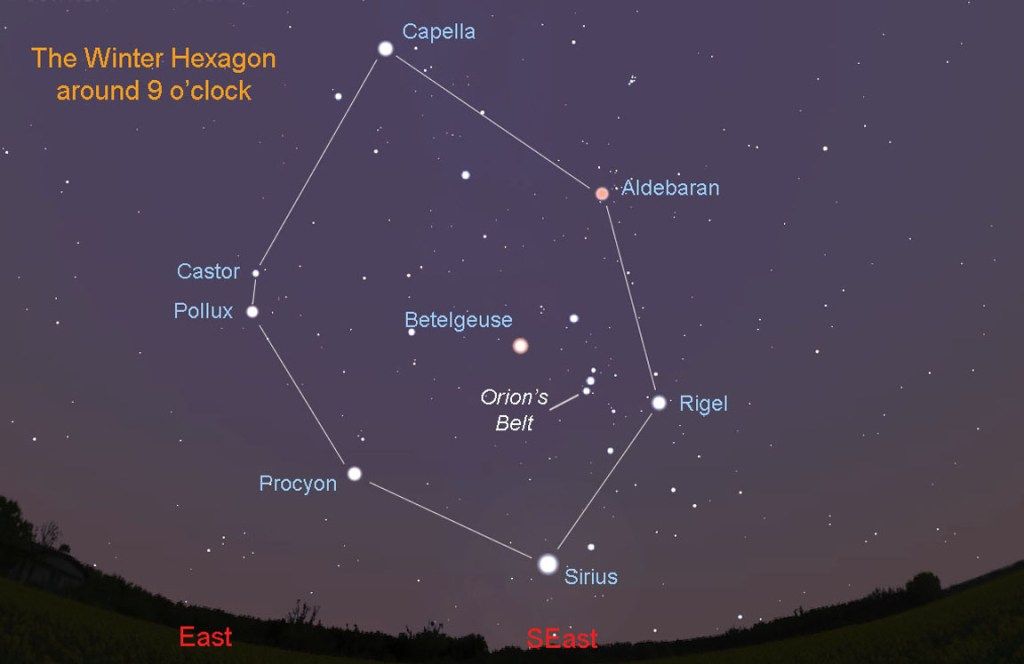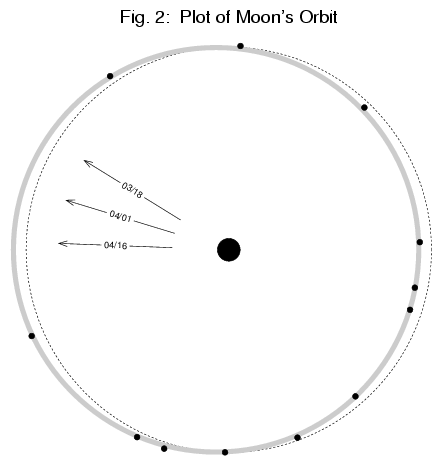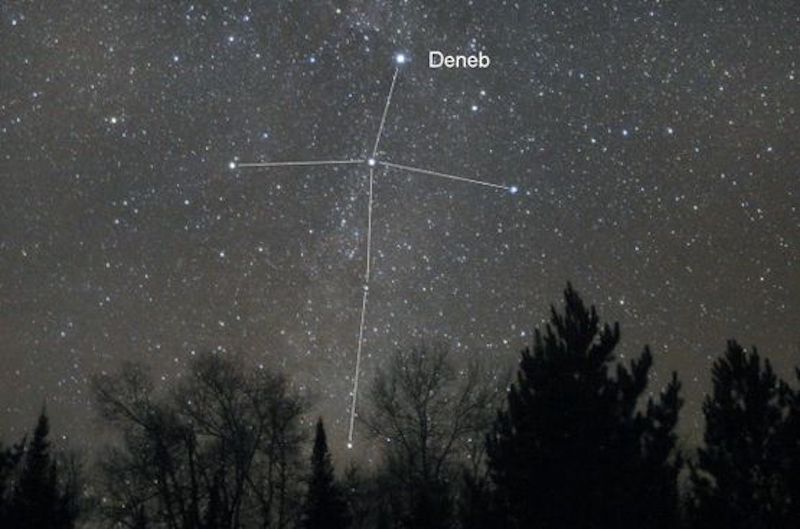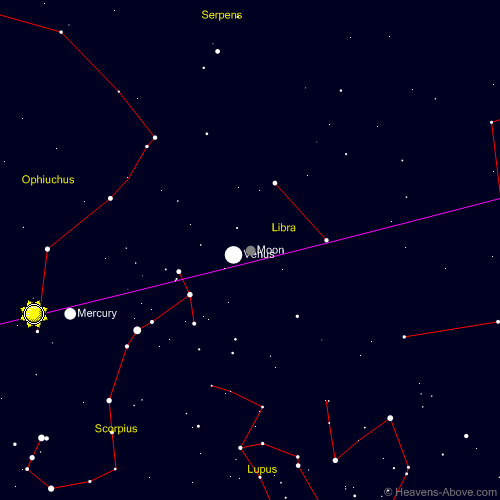207-780-4249 www.usm.maine.edu/planet
70 Falmouth Street Portland, Maine 04103
43.6667° N 70.2667° W
Altitude: 10 feet below sea level
Founded January 1970
Julian Date: 2459186.16
2020-2021: LII
THE DAILY ASTRONOMER
Wednesday, December 2, 2020
December 2020 Night Sky Calendar Part III
Although winter's arrival might cause us some distress, we must admit that few of nature's vistas are as enchantingly beautiful as the winter night sky. First, one can easily see Orion and the array of constellations surrounding him throughout most of the night. The brightest stars within these constellations -Aldebaran in Taurus; Capella in Auriga; Procyon in Canis Minor; Sirius in Canis Major; and Rigel in Orion- form the brilliant and immense star pattern called the Winter Hexagon.

Secondly, the stars are generally easier to observe because there is less radiational cooling during the night due to the colder daytime temperatures. When the weather is warm, the residual heat rises off the ground into the air. Such heat transference induces a great deal of turbulence into the atmosphere that can obscure viewing.
So, while some people might gripe and carp about winter's return, we assert that the coldest season has much to recommend it...at least at night.
THURSDAY, DECEMBER 24: MOON AT APOGEE
The moon does not travel along a perfectly circular orbit. Instead -as is true with all the planets- the moon's revolutionary path is elliptical. Were its orbit circular, the moon's distance from Earth would remain constant. However, this distance constantly changes as the moon moves along this slightly elongated orbit. Today, the moon reaches the most distant orbital point, called "apogee." At this time, the moon will be 251,106 miles (405,010 km) from Earth. This value isn't much greater than its distance at perigee on December 12th: 224,301 miles (361,777 kilometers). In fact, the moon's orbit is nearly circular. Were its elliptical orbit much more elongated, the difference between its perigee and apogee distance would be far greater.

The above image shows a realistic depiction of the moon's orbit. The dotted line represents a perfect circle. We can see that the moon's path only slightly deviates from circularity.
One won't notice much of a difference in the moon's size tonight. Consider this event to be a purely academic one.
FRIDAY, DECEMBER 25: NORTHERN CROSS ON THE WESTERN HORIZON

Although it is one of the Summer Triangle constellations, Cygnus the Swan (the Northern Cross) remains visible early this evening. This cross consists of a long, straight axis intersected by a slightly crooked shorter line. The longer line represents the swan's body. Deneb, the constellation's brightest star, marks the swan's tail. Albireo, a magnitude three star at the longer axis' opposite side, forms the head. The shorter axis represents its wings and contains no prominent star apart from Gamma (Sadr), the "breast star" that marks the intersection point between the two star lines.
Mythologically, Cygnus is the swan into which Zeus transformed himself before he seduced Queen Leda, wife of Tyndareus. Within one night Leda had relations with both her husband and Zeus (in swan form). Consequently, she gave birth to four children. Two of the children -Castor and Clytemnestra- were sired by Tyndareus. The other two -Helen and Pollux- were Zeus' children. Castor and Pollux, the Gemini twins -or Dioscuri- matured to become powerful and renown warriors. Pollux enjoyed the advantage of immortality by virtue of his lineage. When Castor was slain in battle, Pollux offered to relinquish his immortality and give it to his fallen brother. Although he declined this request, Zeus was so moved by his selfless gesture that he placed the twins in the night sky as the constellation Gemini. Helen's abduction by Trojan prince Paris precipitated the Trojan War. Clytemnestra married Agamemnon, the King of Mycenae. and brother of Menelaus, Helen's husband. Prevailing winds prevented Agamemnon from launching his ships to Troy to participate in the war. Having learned that moon goddess Artemis cast these winds to punish him for slaying a hind sacred to her, Agamemnon was told that he had to sacrifice his daughter Iphegenia in order to calm the winds. Most reluctantly, he performed the sacrifice and allowed the ships to sail for Troy. When he returned from the war ten years later, his Clytemnestra and her lover Aegithus.
Astronomically, the Northern Cross' longer axis runs along the Milky Way, a luminescent band extending between both horizons. This luminous arc is formed by the collective light of myriad stars aligned along the galactic plane. As the above image is a time exposure photograph, the Milky Way's brightness is exaggerated.
TUESDAY, DECEMBER 29: FULL MOON
Every full moon has a special name. Actually, any full moon will have a variety of sobriquets. December's full moon is known as the "Cold Moon," "Hoar Frost Moon." "Snow Moon," "Winter Maker Moon," and the "Long Night Moon."
Every full moon has a special name. Actually, any full moon will have a variety of sobriquets. December's full moon is known as the "Cold Moon," "Hoar Frost Moon." "Snow Moon," "Winter Maker Moon," and the "Long Night Moon."
All but the final name refers to the season. Winter, as we all know, will begin this month. The "Long Night Moon" refers to the moon's angle. The full moon that occurs closest to the winter solstice will follow a higher path than any of the year's other full moons. For this reason, it remains in the sky longer than any other full moon.
For instance: on December 29th, the moon will rise at 3:46 p.m. and will set at 6:53 a.m. on December 30th. The moon will remain above the horizon for 15 hours and 7 minutes
The June 5th full moon rose at 8:24 p.m. and set at 4:53 a.m. the following morning. That moon spent 8 hours and 19 minutes above the horizon.
A high-flying full moon is yet another reason to experience the gorgeous winter night sky.
PLANET WATCH
MERCURY
Host constellations: Scorpius; Libra; Ophiuchus; Sagittarius
Planet One is barely visible early in the predawn eastern sky during the first three days of December. After this apparition, Mercury will appear too close to the Sun to be visible or the rest of the month. VERDICT: Venture outside on 12/3 around 6:20 - 6:40 a.m. and you MIGHT see Mercury quite low above the eastern horizon. As the Sun rises at 6:57 a.m. on that date, Mercury will quickly vanish into the dawn light. Try again, perhaps, later this week, but by the weekend, Mercury will be out of sight until next year.
VENUS PICK PLANET!!
Host constellations: Libra; Scorpius; Ophiuchus
Except for Mercury during the earliest part of December, Venus will be the only planet visible in the eastern morning sky. As it is always brighter than any other world (save the Moon), Venus is often our pick planet. One will find it easily after 5:00 a.m. Venus resembles a dazzlingly bright star that will slowly fade out of sight as the dawn light intensifies. VERDICT: If you're an early riser, you will want to brave the late autumn/early winter chill and seek out Venus. Our sister world will remain the 'morning star' throughout most of the winter, as it is due to move into inferior conjunction on March 26, 2021.
HIGHLIGHT: Venus will appear extremely close to the moon on December `12th. (See star chart below.)
HIGHLIGHT: Venus will appear extremely close to the moon on December `12th. (See star chart below.)

MARS
Host constellation: Pisces
Though not nearly as bright this month as it was when it reached opposition in mid-October, Mars remains a conspicuously bright planet through the month. At month's beginning, Mars (magnitude -1.0) will outshine all the night sky stars except Sirius. At month's end Mars will shine at magnitude -0.2, making it slightly brighter than Arcturus, the night sky's fifth brightest star. Mars begins the night high in the eastern sky. At the start of December, the fourth world will set around 2:20 a.m. At month's end, it will set by 1:30 a.m. VERDICT: Perfectly placed for skywatchers who prefer early evening to early morning. Even though its brightness will diminish throughout December, Mars is still easy to find provided one looks into the eastern sky soon after darkness descends.
HIGHLIGHT: Mars will be six degrees north of the moon on December 23rd.
JUPITER
Host constellations: Sagittarius (first half of December); Capricornus (second half)
Jupiter is brighter than any planet, save Venus. One will find it well over in the western sky after dusk. Jupiter will set before 7:30 p.m. at the beginning of December and by 6:00 p.m at month's end. VERDICT: Venture out early to find Jupiter. Look over into the western sky during the early evening anytime this month. As Jupiter will move into superior conjunction on January 28, 2021, it will draw ever closer to the Sun and by early January will vanish. Catch it while you can!
HIGHLIGHT # 1: See the moon, Jupiter and Saturn close together on December 17th (This will be about the time Jupiter shifts from Sagittarius into Capricornus.)
.png%22&N=skychart (1).png)
HIGHLIGHT # 2: Jupiter will be in conjunction with Saturn. At closest approach, the two planets will be within 6' of each other. The closest Jupiter-Saturn conjunction since 1623!
SATURN
Host constellations:
Sagittarius (first half of December); Capricornus (second half)
Poor Saturn will always play second fiddle to Jupiter. This secondary role is particularly evident now that the two planets are so close together in the western early evening sky. At magnitude 0.6, Saturn will be about nine times dimmer than Jupiter throughout the month. VERDICT: If you're out to find Jupiter, anyway, might as well seek out Saturn. Saturn will appear to draw ever closer to Jupiter during the first three weeks of December.
HIGHLIGHT: Saturn will be in conjunction with Jupiter on December 21st. At closest approach, the two worlds will be separated by 6'. The closest conjunction since 1623! (Yes, we know you read about that already.)
To subscribe or unsubscribe from the Daily Astronomer: